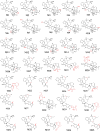Metabolites of Vinca Alkaloid Vinblastine: Tubulin Binding and Activation of Nausea-Associated Receptors
- PMID: 31460070
- PMCID: PMC6648052
- DOI: 10.1021/acsomega.9b00652
Metabolites of Vinca Alkaloid Vinblastine: Tubulin Binding and Activation of Nausea-Associated Receptors
Abstract
Vinblastine (VLB) is an antimitotic drug that binds to the vinca site of tubulin. The molecule possesses a high molecular weight and a complex chemical structure with many possibilities of metabolization. Despite advances in drug discovery research in reducing drug toxicity, the cause and mechanism of VLB-induced adverse drug reactions (ADRs) remains poorly understood. VLB is metabolized to at least 35 known metabolites, which have been identified and collected in this present work. This study also explores how VLB metabolites affect nausea-associated receptors such as muscarinic, dopaminergic, and histaminic. The metabolites have stronger binding interactions than acetylcholine (ACh) for muscarinic M1, M4, and M5 receptors and demonstrate similar binding profiles to that of the natural substrate, ACh. The affinities of VLB metabolites to dopaminergic and histaminic receptors, their absorption, distribution, metabolism, excretion, toxicity properties, and the superiority of VLB to ACh for binding to M5R, indicate their potential to trigger activation of nausea-associated receptors during chemotherapy with VLB. It has been shown that metabolite 20-hydroxy-VLB (metabolite 10) demonstrates a stronger binding affinity to the vinca site of tubulin than VLB; however, they have similar modes of action. VLB and metabolite 10 have similar gastric solubility (FaSSGF), intestinal solubility (FeSSIF), and log P values. Metabolite 10 has a more acceptable pharmacokinetic profile than VLB, a better gastric and intestinal solubility. Furthermore, metabolite 10 was found to be less bound to plasma proteins than VLB. These are desired and essential features for effective drug bioavailability. Metabolite 10 is not a substrate of CYP2D6 and thus is less likely to cause drug-drug interactions and ADRs compared to its parent drug. The hydroxyl group added upon metabolism of VLB suggests that it can also be a reasonable starting compound for designing the next generation of antimitotic drugs to overcome P-glycoprotein-mediated multidrug resistance, which is often observed with vinca alkaloids.
Conflict of interest statement
The authors declare no competing financial interest.
Figures











References
-
- Johnson I. S.; Armstrong J. G.; Gorman M.; Burnett J. P. Jr. The Vinca Alkaloids: A New Class of Oncolytic Agents. Cancer Res. 1963, 23, 1390–1427. - PubMed
-
- Malik M. Z.; Ahmad M.; Muahammad S.; Aamir M. N. Pharmacokinetic evaluation of anticancer drugs in Hodgkin’s lymphoma patients after their simultaneous administration. Pak. J. Pharm. Sci. 2016, 29, 2079–2082. - PubMed
LinkOut - more resources
Full Text Sources

